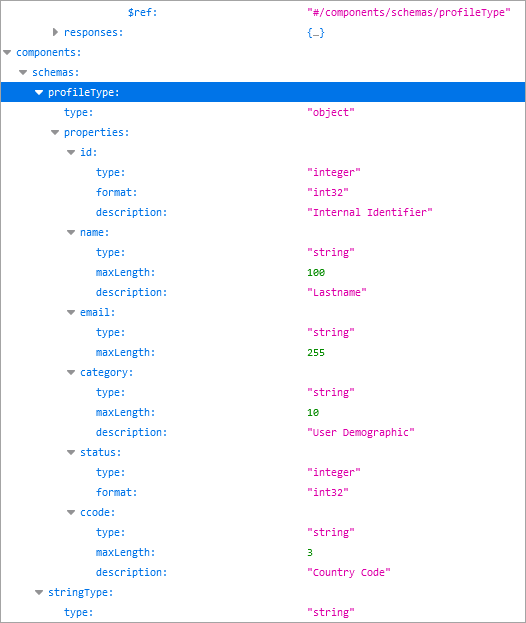WSDescription
Describes the REST function, parameters, return values, and members of user-defined types.
Syntax
WSDescription=" description "- description provides a description of the parameter, function, or return value it is applied to.
WSDescription is an optional attribute.
Usage
WSDescription on:- Any input and output parameter of a REST operation.
- The attribute clause of the function.
- Members of a user-defined type.
Information you specify with this attribute, is generated in
the OpenAPI documentation file. You can control generation of descriptions in the stub file with the
--comment option of the fglrestful tool.
Example 1: using WSDescription in the function and parameters
- The
statparameter is set with theWSQueryand the WSName attributes. In a call to the function, the query string of the URI must be set by the name specified byWSName, such as http://myhost:6394/gas/ws/r/myGroup/myXcf/Accounts/users?status=1 - The
ccodeparameter is set with theWSCookie,WSName, and theWSOptionalattributes. If the client application calling the function provides a value for the cookie in the request, the name specified byWSNamemust be set in the query string of the URI, such as http://myhost:6394/gas/ws/r/myGroup/myXcf/Accounts/users?status=1&country=FRA - The
catparameter is set with theWSHeader,WSName, and theWSOptionalattributes. The client application calling the function has the option of providing a value for a header named "category" in the request.
COALESCE function is used to
produce a query that supports the parameters that are optional and may have no values.WSThrows is set to handle errors. In the TRY/CATCH block, the sqlca record is checked after
the execution of the SQL query. The SQLERRMESSAGE is set to the
message field of the userError variable, and a call to
SetRestError() returns the message defined in WSThrows
for the error.
IMPORT com
TYPE profileType RECORD
id INTEGER,
name VARCHAR(100),
email VARCHAR(255),
category VARCHAR(10),
status INTEGER,
ccode VARCHAR(3)
# ...
END RECORD
PUBLIC DEFINE userError RECORD ATTRIBUTES(WSError = "User error")
message STRING
END RECORD
PUBLIC FUNCTION getFilteredUsers(
stat STRING ATTRIBUTES(WSQuery, WSName = "status",WSDescription = "Status is true(1) or false(0)" ),
ccode STRING ATTRIBUTES(WSCookie, WSOptional, WSName = "country",WSDescription = "Country code"),
cat STRING ATTRIBUTES(WSHeader, WSOptional, WSName = "category",WSDescription = "Product category")
)
ATTRIBUTES (WSGet,
WSPath = "/filteredUsers",
WSDescription = "Gets users based on query, cookie, and header values.",
WSThrows = "400:Invalid,406:@userError" )
RETURNS ( DYNAMIC ARRAY ATTRIBUTES(WSName = "Users_status",
WSMedia = "application/json") OF profileType)
DEFINE arr DYNAMIC ARRAY OF profileType
DEFINE i INTEGER = 1
TRY
# The SQL COALESCE function produces a query that supports null parameters
DECLARE c2 CURSOR FOR SELECT * FROM users
WHERE users.status = stat
AND users.country = COALESCE(ccode,users.country)
AND users.category = COALESCE(cat,users.category)
ORDER BY users.name ASC
FOREACH c2 INTO arr[i].*
LET i = i+1
END FOREACH
CALL arr.deleteElement(arr.getLength())
# Remove the empty element implied by reference in FOREACH loop
CATCH
LET userError.message = SFMT("Error in SQL execution: %1 [%2]",
sqlca.sqlcode, SQLERRMESSAGE )
CALL com.WebServiceEngine.SetRestError(406,userError)
END TRY
RETURN arr
END FUNCTIONExample 2: using WSDescription in a type definition
WSDescription attribute describes members of the
user-defined type profileType. TYPE profileType RECORD
id INTEGER ATTRIBUTES (WSDescription="Internal Identifier"),
name VARCHAR(100) ATTRIBUTES (WSDescription="Lastname"),
email VARCHAR(255),
category VARCHAR(10) ATTRIBUTES (WSDescription="User Demographic"),
status INTEGER,
ccode VARCHAR(3) ATTRIBUTES (WSDescription="Country Code")
# ...
END RECORDIn the OpenAPI documentation, the profileType will be referenced in the
#/components/schema section. The GWS engine exposes the description property for
the elements defined with WSDescription in the schema.
